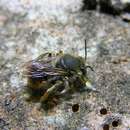Brief Summary
provided by Catalog of Hymenoptera in America North of Mexico
This is one of the largest families of bees and is represented by about an equal number of species in each of the six zoogeographic regions. It is morphologically the most uniform and discrete familial assemblage within the Apoidea. While many of the characteristics of this family are shared with other families of bees and to a lesser extent with the Sphecoidea, the Megachilidae also possess many characteristics in common with the Scolioidea. ~The family is composed of three subfamilies, the Fideliinae and Lithurginae which are all pollen-collecting bees, and the Megachilinae which are predominantly pollen-collecting species, but which contain several genera that are cleptoparasitic mainly in the nests of other megachilids. The Fideliinae are found only in Chile and South Africa, but both of the other subfamilies are nearly cosmopolitan and are well represented in America north of Mexico. Most of the pollen-collecting species do not make their own burrows, but appropriate a wide variety of pre-existing burrows, holes, shells and other cavities or construct their nests either in the open attaching them to branches and so forth, or place them under stones, cow chips and so on. As a consequence of these habits, many species readily accept artificial nesting devices, and this has not only permitted detailed studies of their biology, but has also made possible the manipulation and management of several species for use in the pollination of agricultural crops. However, some species in certain genera (e.g., Megachile) and even some groups of species (e.g., Heteranthidium and Trachusa) do construct their own burrows. All of the pollen-collecting Megachilidae use foreign materials in the construction of the cell walls. These materials include leaves, plant down, leaf pulp, petals, resin, pebbles, mud, clay, and the like. The larvae spin tough cocoons before pupation. ~Apart from the cleptoparasitic species, many of the megachilids are highly restricted in their intrafloral relationships and thus oligolecty is a relatively common phenomenon in this family.
- bibliographic citation
- Catalog of Hymenoptera in America North of Mexico. 1979. Prepared cooperatively by specialists on the various groups of Hymenoptera under the direction of Karl V. Krombein and Paul D. Hurd, Jr., Smithsonian Institution, and David R. Smith and B. D. Burks, Systematic Entomology Laboratory, Insect Identification and Beneficial Insect Introduction Institute. Science and Education Administration, United States Department of Agriculture.

